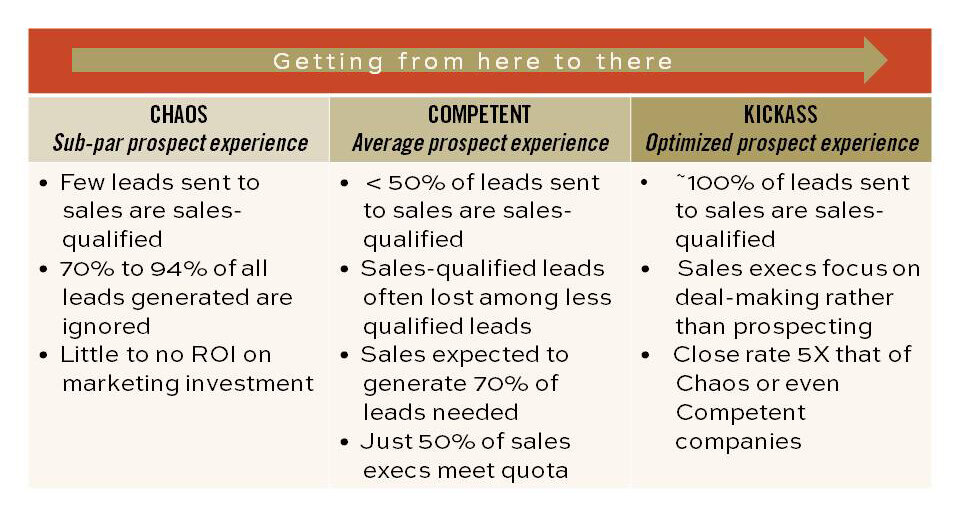From Chaos to Kickass
By Dan McDade, Managing Partner, Prospect-Experience
How well are your B2B organization’s sales and marketing behaviors, practices and processes reliably and sustainably producing required outcomes?
Are you mired in chaos, spending lots of time getting little done?
Are you like most companies, achieving just average results and not knowing why?
Or are you among the few that are kicking it?
No matter where you are now, there are steps you can take to substantially improve results. You can emerge from a chaotic state … you can rise above average … and you can achieve the state of fully optimized prospect experience.
Transforming Your Prospect Experience
Winston Churchill once said, “I never worry about action, only inaction.” I’ll be blunt. The problem with most companies’ marketing and sales today is confusion about what action really is. Activity is not action. Many companies today are executing activities—with not near enough actionable results. A kickass prospect experience outperforms average companies many times over.
Out performers generate five times the revenue based on comparable starting places. To the left is a comparison of results for average companies as compared to optimized companies:
A Competent (average) company closes just 2.8 deals for every 1,000 prospects. Kickass (optimized) companies close 14 deals for every 1,000 prospects. Based on these statistics, what company wouldn’t want to optimize their prospect experience? As a senior executive, you can easily do your own math to understand what achieving a kickass level of prospect experience could mean to your bottom line.
12-Point Prospect-Experience Transformation Process
The road from Chaos to Kickass starts and ends with the prospect experience. While the term customer experience is a familiar one—describing the interactions between your company and your customer—prospect experience refers the interactions between your company and the people you are selling to. The customer experience helps you keep customers, the prospect experience helps you acquire them in the first place.
Optimization of the prospect experience begins by putting in place transformation processes. Getting from here to there (from sub-par Chaos to optimized Kickass) means you do what it takes to generate more leads, move more targets through the pipeline, and convert more prospects to customers. How your organization (specifically marketing and sales) treat prospects has huge potential to impact revenue and growth.
At the macro level there are three groupings of prospect experience activities. They are Market, Message and Method. Each of these is broken down into four components as follows:
Market
Figure out exactly who you’re selling to and why. Get the most out of your prospecting efforts.
Message
Determine the right way to attract prospects’ attention—and continue to move them through the pipeline.
Method
Test and analyze for continual improvement, measure what matters and make sure everyone knows how things are going
Together these prospect experience steps are what it takes to acquire customers—and impact your organization’s revenue and growth.
Possible Objections
Before we get into the details let me address objections I hear when talking to marketing and sales leaders out in the field. The more senior you are in your organization the more likely it is that you feel that the actions outlined above should be handled by other managers tasked with marketing or sales responsibility.
The reality is that each of the 12 components requires highly specialized knowledge and deep experience. This is a science with a proven path to success. It’s also hard work. There are no pat answers (remember “cold calling is dead”?). There are no short-cuts (each cycle needs eight to 12 touches). And it’s not easy (reading a script is not going to generate a qualified B2B lead). Without careful attention to each of the 12 steps of prospect experience transformation, your well-intentioned managers will slip into an abyss of unfortunate decision-making.
Market: Why Getting the “Who” Right is Key
Marketing and sales generally do not share the same, or even a similar definition of a lead. That‘s why sales for the most part disregards “marketing leads,” leaving them to perish in the black hole called CRM. When marketing has one definition of a lead and sales has another, the group’s work against each other, waste time and money, and the competition wins. To arrive at a common definition of a lead, marketing and sales have to agree on the answers to key questions: Do we recognize the value of a longer-term lead and the opportunity we have for developing a relationship? Is a good lead only one where a c-level executive is involved? Do we prioritize influencers in larger-size deal? A collaborative approach to making sure everyone agrees to what constitutes a lead—with some accountability built in on both sides—is critical.
Where’s there’s no common definition of a lead, it’s not possible to pinpoint a total addressable market (TAM). What happens then is the company prospects too broadly and ends up with a TAM that’s a bottomless pit. Pinpointing markets based on size, vertical, location, environment and need give marketers and salespeople the focus they need to be as productive as possible.
Determining which prospects can be most efficiently worked makes you more productive. Prioritizing high-return segments—to the point of diminishing return—increases results by up to 50% and reduces cost of sales by as much as 30%. Taking the time to mathematically segment your market delivers more results than a shotgun approach every time.
A final but important component of the prospect experience effort around market is making sure you consistently capture and report on the actionable market intelligence encountered in your everyday prospect experience efforts. There’s no such thing as a wasted call. Each touch is an opportunity to collect data that makes the next touch more productive. How satisfied are users of competitive solutions? What do they need? How mature is the market? Documenting these insights helps you sell more.
Message: “What” Your Prospects Hear from You Is Crucial
While most companies say they sell a solution, not a product or service, the message around what that offering (made up of a product, price and delivery mechanism) is more likely than not described differently by every marketing and sales executive in the organization. Do we provide staffing, or are we an HR services firm? Are we a niche vendor, consultant, or service aggregator? All involved need to agree and have ability to articulate who we are, what we do, and what value we bring consistently and concisely.
The value statements that everyone needs to know how to articulate include the defendable differentiators that set your company apart. The prospect experience depends on your people’s ability to clearly understand how your offering stands out.
All of the above is documented carefully in a prospect experience playbook. This 15- to 20-page document that includes everything your team needs to generate, qualify, nurture and close leads. Processes, company/product background, competitive landscape, cultural values, call flows, response to objections shape consistent communication—and help team members perform at their best.
A marketing resource assessment and plan free up the marketing team. Instead of responding to ad hoc requests from sales for case studies, whitepapers, data sheets, etc., it’s important to identify what’s required to get the job done and put together a plan to prioritize development of materials that don’t exist. Most companies produce more marketing content than they need.
Method: “How” You Engage with Prospects Matters
What percent of prospects become leads, pipelines and nurtures? What percent of MQLs become SQLs? What percent of SQLs should close? Understanding where you are and furnishing your marketing and salespeople with a road map to get you where you want to go is an important piece of the prospect experience puzzle. Locked down benchmarking, metrics and reporting processes are essential to prospect experience transformation.
How many dials per day? How many voicemails per day? How many emails per day? How many dials, voicemails and emails per prospect per touch cycle? How long is the touch cycle? Testing helps you continuously manage the cadence to be most effective, and is critical to optimizing the prospect experience.
While nurturing can triple return on your marketing investment—it’s the most underutilized activity at a marketer’s disposal. When you make multi-cycle nurturing processes part of your workflow, no lead is left behind. There’s a next step for every outcome, and that will help you get more value out of your lead development spend.
Companies over invest in technology. Automation can help you scale, but if you’re automating bad processes then all you’re doing is getting more poor-quality leads to sales faster than ever. Tools in your sales and marketing technology stack that work together to add value is crucial to prospect experience transformation.
The customer experience helps you keep customers. The prospect experience helps you acquire them in the first place.
Who are our prospects? What is our offer? How do we achieve (and measure) results? Answering these questions will help you optimize your prospect experience—and accomplish the sales and marketing goals you need.



